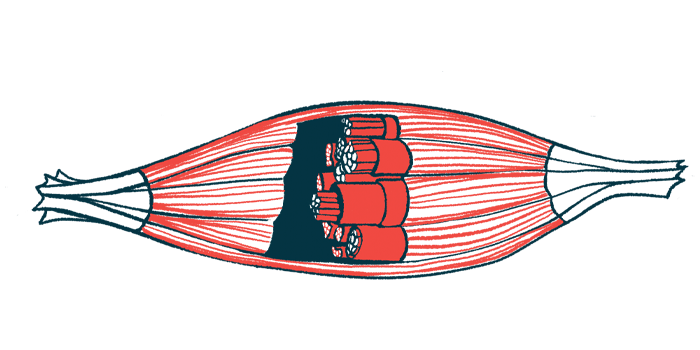SMN Protein May Also Be Target for Age-related Muscle Decline


Disease-modifying therapies (DMTs) used for spinal muscular atrophy (SMA) may contribute to the development of therapies for age-related progressive loss of muscle mass and strength, or sarcopenia, new research suggests.
The survival muscle neuron (SMN) protein, whose deficiency causes SMA, was found at progressively lower levels with aging in mice. This suggests current SMA-approved DMTs, focused on increasing SMN levels, may help to prevent or slow age-related muscle decline.
“We found that SMN protein and aging are related – there is a decline in the protein with age and it correlates with a decline in neuromuscular function,” said Maria Balch, PhD, the study’s first author and a postdoctoral scholar in neuroscience at Ohio State University’s College of Medicine, in a university news release. “Based on what we know about SMA and therapeutics, we have background in targeting SMN protein — and it’s possible that could be something down the line that could be applied to age-induced neuromuscular decline.”
The findings were presented in the poster “Age-associated reduction of survival motor neuron protein as a potential target for sarcopenia,” at Neuroscience 2022, the annual meeting of the Society for Neuroscience, Nov. 12–16 in San Diego.
SMA is caused by mutations in the SMN1 gene that lead to reduced levels of SMN protein, which is critical for the health of motor neurons, the nerve cells that regulate voluntary movement, and the muscles they control.
As such, SMN deficiency leads to the death of motor neurons, resulting in the progressive muscle weakness and atrophy that are features of SMA.
A second SMN gene, called SMN2, can partially compensate for the loss of SMN1-derived SMN, producing about 10–15% of working SMN protein. In SMA patients, a higher number of SMN2 gene copies is associated with milder forms of the disease.
SMN protein and sarcopenia
Considering the importance of SMN protein for the motor neuron and muscle health, Balch and colleagues at Ohio State University investigated whether the SMN protein is involved in age-related sarcopenia.
Previously, the team found that mice engineered to produce SMN at levels above normal had increased longevity and neuromuscular resistance, and recovered faster from nerve injury.
“That raised some questions,” said Arthur Burghes, PhD, one of the study’s senior authors and a professor at the biological chemistry and pharmacology, and molecular genetics departments at Ohio State. “Different people get different amounts of weakness with age. Why are some people completely resistant to it, and other people are more susceptible?”
Burghes developed the first mouse model of SMA that contributed to the development of Zolgensma, a disease-modifying gene therapy for SMA.
“With aging and sarcopenia, there is an increased chance of injury due to falling. So it’s an important problem,” Burghes said.
Although a combination of genetic factors and behavior is thought to play a role in developing sarcopenia with aging, promoting SMN production might be a therapeutic approach for the disease.
Promoting SMN production for muscle loss
In the current study, the researchers analyzed SMN levels, motor neuron health, and muscle function in healthy mice of three age groups: 6 to 10 months (roughly corresponding to 35–50 in human years), 21 months (about 55 human years), and 27 months (over 70 human years).
They found that increasing age was significantly associated with lower SMN levels, lower muscle response to motor neuron stimuli, fewer working motor units, and lower gastrocnemius muscle weight.
Motor units comprise motor neurons plus the muscle cells they supply. The gastrocnemius is the large calf muscle located at the back of the lower leg.
We found that SMN protein and aging are related – there is a decline in the protein with age and it correlates with a decline in neuromuscular function.
SMN levels in motor neurons of older mice were 55% lower than those in younger mice (6–10 months) and were linked to a significantly lower gastrocnemius muscle weight, and to a trend toward lower muscle contraction when stimulated.
Older mice also showed 22% lower SMN levels in the spinal cord relative to younger mice. This was significantly associated with fewer motor units and lower gastrocnemius muscle weight.
Researchers found that, besides reduced SMN protein levels, older mice display a reduction in the number of motor units and a decline in the function of muscles responding to nerve stimulation.
“In summary, age-associated reduction of SMN protein is a potential target for sarcopenia intervention and, considering the current therapeutic landscape for patients with SMA, represents an easily-translatable approach for application in aging,” the researchers wrote.
The team is now conducting preclinical studies to investigate how different strategies to increase SMN levels affect symptoms of sarcopenia.
Possible approaches include targeting the SMN2 gene to produce more working SMN protein (similar to the SMA-approved DMTs Spinraza and Evrysdi) or delivering an extra copy of the SMN1 gene to cells through a harmless adeno-associated virus (similar to Zolgensma).
Viral-based gene therapies may not be applicable to sarcopenia, however, due to the large amount of virus needed to treat an adult, the team noted.
“We know in the field of SMA that targeting an increase in SMN protein can be approached from different directions. If we can determine that this is a viable therapeutic target in aging, there’s a lot of research we can lean on to help drive the direction of age-related therapeutics,” Balch said.
The post SMN Protein May Also Be Target for Age-related Muscle Decline appeared first on SMA News Today.





